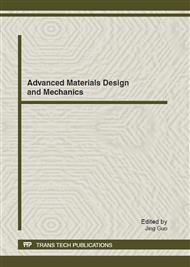[1]
L. C. Shackelford, A. D. LeBlanc, T. B. Driscoll, H. J. Evans, N. J. Rianon, S. M. Smith, E. Spector, D. L. Feeback and D. Lai. Resistance exercise as a countermeasure to disuse-induced bone loss. J Appl Physiol 97: 119-129, (2004).
DOI: 10.1152/japplphysiol.00741.2003
Google Scholar
[2]
LeBlanc A, Schneider V, and Shackelford L. Bone mineral and lean tissue loss after long duration space flight. J Musculo Neur Interact 1: 157–160, (2000).
Google Scholar
[3]
LeBlanc AD, Driscol TB, Shackelford LC, Evans HJ, Rianon NJ, Smith SM, Feeback DL, and Lai D. Alendronate as an effective countermeasure to disuse induced bone loss. J Musculo Neuron Interact 2: 335–343, (2002).
DOI: 10.1152/japplphysiol.00741.2003
Google Scholar
[4]
Schneider SM, Amonette WE, Blazine K, Bentley J, Lee SM, Loehr JA, Moore AD Jr, Rapley M, Mulder ER, and Smith SM. Training with the International Space Station interim resistive exercise device. Med Sci Sports Exerc 35: 1935–1945, (2003).
DOI: 10.1249/01.mss.0000093611.88198.08
Google Scholar
[5]
Information on http: /www. asc-csa. gc. ca/eng/astronauts/living_exercising. asp.
Google Scholar
[6]
Roberson, R. E., Comments on the incorporation of man into the attitude dynamics of spacecraft. The Journal of the Astronautical Sciences, 1963, X, 27-28.
Google Scholar
[7]
Thomson, W. T. and Fung, Y. C. Instability of spinning space stations due to crew motion. AIAA Journal, 1965, 3, 1082-1087.
DOI: 10.2514/3.3058
Google Scholar
[8]
Poli, C. R., Effect of man's motion on the attitude of a satellite. Journal of Spacecraft, 1967, 4, 15-20.
Google Scholar
[9]
Newman, D. J., Schaffner G., Computational dynamic analysis of extra vehicular activity(EVA): Large mass handling, Journal of Spacecraft and Rockets, 1998, 35(2): 225-227.
DOI: 10.2514/2.3313
Google Scholar
[10]
Wang Juan, Zhuang Damin. Human modeling and simulation based on Lagrangian method in weightlessness. Journal of Beijing University of Aeronautics and Astronautics, 2006, 32(3): 254-257.
Google Scholar
[11]
NED J. PENLEY, CRAIGP. SCHAFER and JOHN DAVID F. BARTOE. The International Space Station as a microgravity research platform. Acta Astronautica Vol. 50, No. 11, p.691–696, (2002).
DOI: 10.1016/s0094-5765(02)00003-6
Google Scholar
[12]
Newman, D. J., Tryfonidis, M. and van Schoor, M., Astronaut-induced disturbances in microgravity. Journal of Spacecraft and Rockets, 34, 252-254.
Google Scholar
[13]
P.R. Cavanagh, K.O. Genc, R. Gopalakrishnan, M.M. Kuklis, C.C. Maender, A.J. Rice. Foot forces during typical days on the international space station. Journal of Biomechanics, 2010, 43: 2182–2188.
DOI: 10.1016/j.jbiomech.2010.03.044
Google Scholar
[14]
Haug, E.J. Intermediate Dynamics, Prentice-Hall, Englewood Cliffs, NJ, (1992).
Google Scholar
[15]
Haug, E. J. Computer Aided Kinematics and Dynamics of Mechanical Systems, Vol. 1: Basic Methods, Allyn and Bacon, Boston, (1989).
Google Scholar
[16]
Bae, D.S., and Haug, E.J., 1987, A recursive formulation for constrained mechanical system dynamics: part I: open-loop systems, Mechanics of structures & Machines, vol 15, pp.359-382.
DOI: 10.1080/08905458708905124
Google Scholar
[17]
Bae, D.S., Haug, E.J. A recursive formulation for constrained mechanical system dynamics: part II. closed loop systems. Mechanical Structures and Machines 1987; 15(4): 481-506.
DOI: 10.1080/08905458708905130
Google Scholar
[18]
Bae, Dae Sung. A Recursive Formulation for Constrained Mechanical System Dynamics. Ph.D. Thesis, The University of Iowa, Iowa city, (1986).
Google Scholar
[19]
Tsai, F.F. and Haug, E.J. Automated Methods for High Speed Simulation of Multibody Dynamic Systems,. Technical Report R-47, Center for Simulation and Design Optimization, College of Engineering, The University of Iowa, Jan. (1988).
Google Scholar
[20]
Shih-Tin Lin and Jhy-Hong Lin. Computer Aided Dynamic Analysis and Simulation of Multibody Mechanical Systems in AutoCAD,. SIMULATION. 1998, 71(5): 328-335.
DOI: 10.1177/003754979807100504
Google Scholar
[21]
Potra F A. Implementation of Linear Multistep Methods for Solving Constrained Equations of Motion. SIAM Journal of Numerical Analysis, 1993, 30(3): 774~789.
DOI: 10.1137/0730039
Google Scholar


